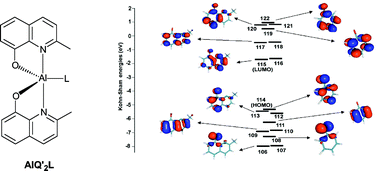Blue emitting pentacoordinated Al(iii) complexes based on 2-methylquinolin-8-olate and substituted phenolate ligands. The role of phenolate derivatives on emission and absorption properties†
Abstract
This paper reports the synthesis, characterisation and photophysical investigation of the homologous series of blue-emitting pentacoordinated AlQ′2L complexes 1–6, where Q′ is 2-methylquinolin-8-olate and L is a phenolate substituted in para to the oxygen donor atom. Both electron attracting and electron releasing substituents have been considered. Also binuclear complexes of formula Q′2Al–L′–AlQ′2, where L′ = OC6H4C6H4O, OC6H4(CH2)3C6H4O and OC6H4C(CH3)2C6H4C(CH3)2C6H4O have been synthesised and characterised. These are interesting blue-emitting materials for OLED (organic light emitting diode) fabrication. A comparison between computational and experimental results allowed the description of the absorption and fluorescence processes. A study of the frontier orbitals involved in the electric conduction and fluorescence emission has been performed. Influences of the phenolate-based


 Please wait while we load your content...
Please wait while we load your content...